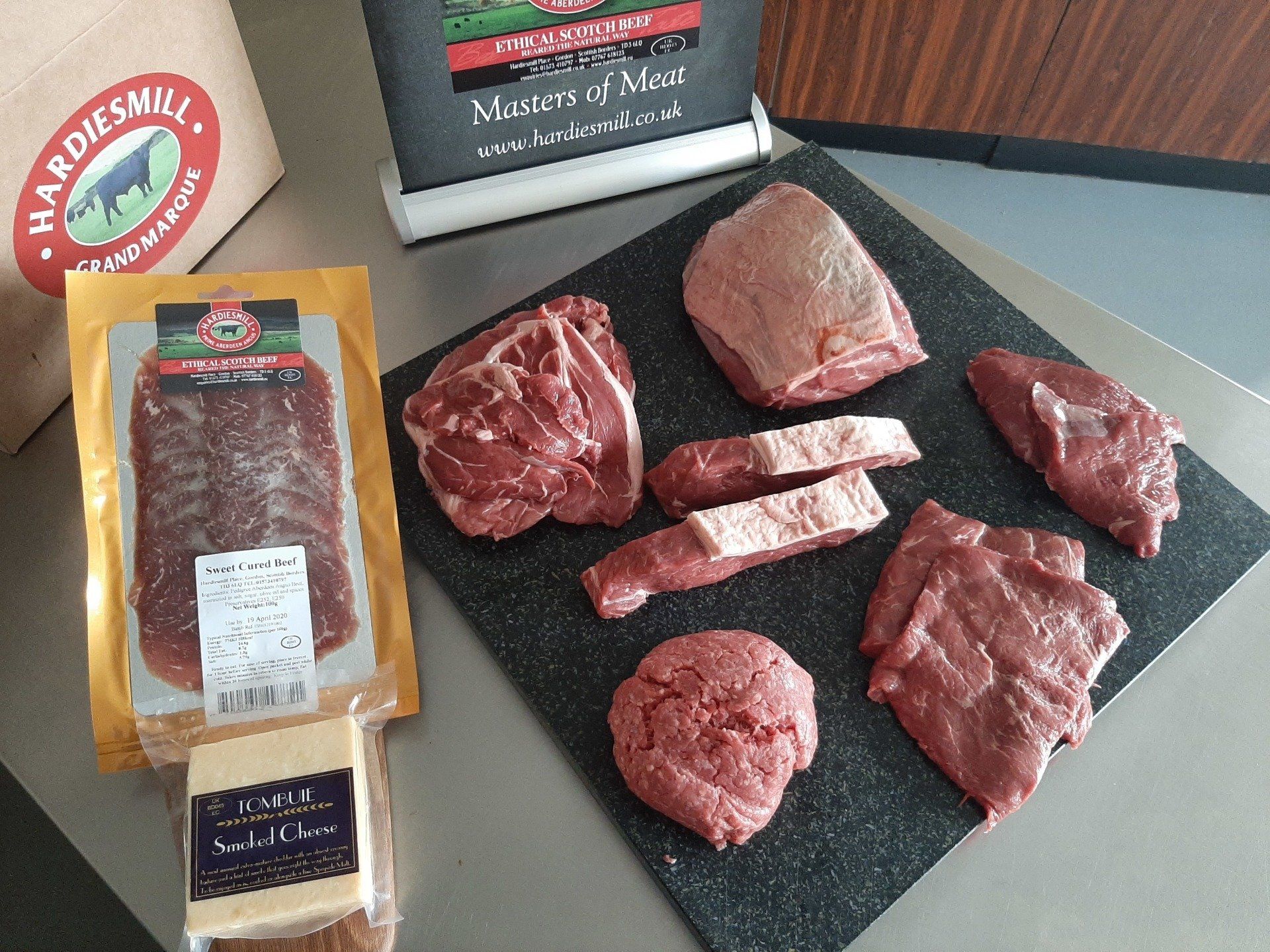Why some people like one steak and others like another
Alison Tuke • 2 June 2020
'Taste over Tenderness' or 'Tenderness over Taste'?

Robin and I often ask new customers the question: “Taste over Tenderness” or “Tenderness over Taste”? It sounds simple, but each person’s palate is different and it’s amazing how a palate reacts to textures, tastes & flavours.
For many years, we had a stand in the food hall at the Highland Show, handing out samples and selling our beef. Over the four days, we watched peoples’ reaction to the tasters and waited for comments: “it’s really tender”, “it’s very beefy”, “it’s salty” etc., all tasting the same product. We found different people liked different things, not surprisingly, but few people had thought about it, especially in couples! How you are when you taste something also affects your palate. If you are thirsty, then it will mean the salt will come to the front.
Texture is the same, each person has likes and dislikes in food, and texture is a big one. Many people aren’t aware that it is the texture that they focus on, but it is a strong part of our palates. I have a dislike for pears, it is not the taste, it is the feeling on my teeth. Robin loves cooked peaches, but not raw – and it is the same thing: texture on teeth. Two different fruits, but the same reaction.
It is how each of us, the eater of the steak, like a steak – taste, tenderness and texture that makes the eating experience. Fortunately, each muscle cut for steak here at Hardiesmill, has a different taste, texture and tenderness - depending how the muscle is worked. We cut a carcass a different way from most butchers, giving us a range of 16 steaks.
The fillet is the least worked muscle in a prime steer or heifer carcass. It is very tender by its nature. However, the breed, the feed that the animal has eaten, how it is aged etc. throughout the its life affects the way it tastes too.
Hardiesmill only has one breed of cattle: Aberdeen Angus. They’re all pure-bred as each crossbreed has a different flavour, just like blended wines.
The grass has a minerality in it given by the different lengths of roots that bring the minerals in the soil to the grass/weeds that they eat.
We age our fillets for a minimum of 6 weeks on the bone, giving them a much deeper flavour than fillet in general.
Another example is Bavette. It’s a flank steak, is an amazing eating experience and so different from a fillet. The flank works much harder as a muscle, it is not as marbled as a fillet, and is not a tubular muscle like a fillet. Is a flat piece of meat that is lean, with an extra-ordinary course texture. You can overcook a bavette and it is not a muscle for those that like their steaks well done! It is a French delicacy and we were introduced to it by a French chef. Wow, it is a wonderful steak! Hung for six to seven weeks it is at its prime – done to the rarer side of medium – ie still pink in the middle, put on a piece of garlic ciabatta with some wonderful ripe tomatoes, it beats any fillet for me! However, it is not Robin’s choice cut. Robin loves the rump – that mixture of the sweet fat, and, care of the slightly more worked muscle than a sirloin, the wonderful palate of flavours. The minerality comes through on the back of the palate as you swallow. He likes it rare, but the rump can go all the way up to well done.
Our Textured steaks, which are called textured steaks as they make people think about the textures of the food they eat, have amazing big flavours, but a little more bite over a fillet. I.e.
Bullet – big 3D flavour, tight grain. Cook rare to medium rare.
Thick Rib – eats like a rump, but leaner. Particularly good with a pepper sauce as the meat comes through the sauce.
Grieve – gentle flavour with a hint of smoke.
Gertjan – big flavour. best rare to medium rare.
Merlin – light flavour with hints of silverside.
Flat-Iron – tender, hung at Hardiesmill for weeks on the bone.
Bavette – coarse grain. Rare
Onglet – big flavour. Almost liver in the flavour. Serve Rare.
Butler’s - subtle flavours and tender.
Spider – like an aged musty wine! Complex. Cook rare.
Jarret has a hint of citrus.
The Prime Steaks as more expensive than the above, theoretically they should be good beef, wherever you buy it from. Here at Hardiesmill, they are from pure-bred animals, they are grass-reared, and they are hung to the best we think they can be!
Fillet – a wonderful mix of extra-ordinary tenderness with a subtle meaty-ness!
Sirloin – a mixture of tender, fat and juicy!
Rib-Eye – the butcher’s fillet, but with fat and a fuller flavour.
Oyster’s of Beef – Rib-eye with attitude and leaner.
Rump – hung well and has a wonderful mixture of juiciness and flavour.
To order from Hardiesmill please go to the shop.
Share

Hardiesmill Beef started in 2001, and were grass-finishing cattle in 2003, way before Grass-Fed cattle was as fashionable as it is today. Why did we decide to grass-feed our cattle then, quite simply we thought the beef tasted better. We turned away from the market-place and decided to sell direct. By early 2003, we finished cattle and were having them killed and butchered to sell in boxes over the UK. It was hard work! We spent our days learning about the different cuts, as north and south of the border and that even regions have different ways to cut a carcass and names for parts of the carcass. We started to collate a glossary of cuts which is on our website. We learnt a great deal. Hardiesmill expanded and we took on a full-time butcher. Lee, who taught us new muscles and we learnt from customers others! The frying pan in hand we tasted a great deal. We continued to sell our beef direct to both restaurants and direct to customers. We went to trade shows, shows and tried to share our passion! By the mid-2010s, we were concentrating on the wholesale side of the business supplying 12 restaurants and Kelso Farmers Market, with two full-time butchers Brian and Stewart. Regular farms finish their cattle in batches/fields and send them to either the local Mart or Direct to Slaughterhouses. These farmers are paid £/kg on the carcass grade a classification of fat covering and shape, built around the European (continental cattle) at the beginning of the 1970s. Butchers shops buy primals or full-carcasses direct from farms, or through wholesalers. These animals are fed to go through the system as fast as possible to a maximum weight of 700kg liveweight, to meet the market required by the butcher. If a butcher buys primal cuts, these have been hung in the abattoir for the minimum time of two weeks. The carcasses are hung for the minimum time, cut and sold. If carcasses are hung for longer, it will be certain cuts not the whole carcass. Currently, there is no reward for eating experience of the beef that is produced. At Hardiesmill, we finish two animals every two weeks, at present, because of Covid-19. Only Hardiesmill animals are slaughtered for our own butchery and no finishing cattle sold to other butchers or marts. In other words, the cattle come from the species rich grasslands at Hardiesmill. Giving the beef a unique taste of the ‘terriore’/minerality from the farm. No grain or concentrate is fed in the animal’s life. In the winter, the animals are in outside corals being fed grass-sileage or hay from our own farm. They are bedded on straw. They are turned out when the new growth appears! This year this is slightly later due to the lack of rain (40% behind the long term average (QMS)). Not that we are complaining, we are grateful for what we are given! The forequarters are hung for two-weeks, broken down into cuts and hung by cut. The Hindquarters are hung for minimum of four weeks, again broken into muscles and hung further according to cut. The fillets are hung for weeks on the bone, giving it a unique taste. We specialise in producing some 18 different steaks (cooked as a regular steak, on or in the grill), depending on whether you like taste over tenderness or tenderness over taste, each is like a wine, the way the muscle works gives a different taste and texture. The Covid-19 situation meant that on 21 March, our business had died with the closure of the restaurants, yet we had carcasses hanging in the chillers! Even Kelso Farmers Market was cancelled, yet we had food able to be sold. We dusted ourselves off and started selling direct to customers again. Appreciating that customers have to drive to find us, learning that courier companies changed their timetables, so everything is ready for 10 am in the morning, and that we have to visit the Post Office lots for those parcels which are heading to surcharge areas of the UK, (anything north of Edinburgh). We have built an on-line shop, learnt to answer the phone as they are not all sales calls for cheap electricity, and that any car passing could be a customer! We have found a good-sized box, for selling retail that is environmentally friendly, we have re-ordered our wonderful @Woolcool’ envelopes. We strive to keep our carbon footprint as low as possible. The cattle are calving and slowly going out to the fresh pasture as the grass grows! We are learning about marketing our beef direct to our customers, facebook posts, photos, etc. Hoping that we can survive the storm and keep doing what we are passionate about = good beef produced in the most ethical way – ie using pure-bred grass-converters to produce best beef! Time will tell if we can, but we do love what we do! To all our customers new and old, we say thank you for the support. Keep safe and Enjoy Hardiesmill Ethical Scotch Beef. If you have questions about the various cuts please don’t hesitate to ask or even how to cook something.

